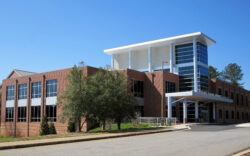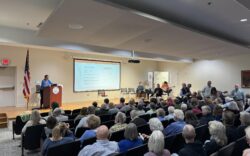For 20 years, people have been calling for changes to the way Prince Avenue looks and works. Different citizen and government groups have analyzed the road, and many of those studies are on a shelf in someone’s office. The latest is the 2020 Prince Avenue Corridor Improvements Project User Group.
Over the years, studies have shown residents want Prince Avenue transformed into a beautiful, safe bike- and pedestrian-friendly gateway into Athens, and not a speedway for commuters barreling toward Piedmont Athens Regional and the University of Georgia. From Milledge Avenue to downtown, the road is managed by the local government. As Prince Avenue heads past the hospital and through Normaltown to the bypass, it’s considered a state highway, the continuation of Georgia State Route 15 and U.S. Route 129, and is managed by the Georgia Department of Transportation.
The purpose of the 2020 user group is to come up with a list of improvements that can be covered with $4 million in local T-SPLOST monies. The group hopes that whatever they suggest “will complement what the state DOT is planning to do,” says Clint McCrory, a retired UGA math professor and member of the group. “Whatever we do has to fit with the state.”
Will safety concerns ever slow the cars and trucks? According to state officials, the GDOT project focuses on safety and is based on recommendations from a 2014 safety audit, which doesn’t include bike lanes. The state plans to spend $4 million on Prince Avenue. The safety project includes “signal upgrades, pedestrian improvements including additional traffic control at midblock crosswalks, as well as the restriping and the addition of medians to improve pedestrian safety and mobility,” according to state documents. Its focus is on safety for pedestrians, but not bike lanes.
On the former site of St. Joseph’s Catholic Church at Pulaski Street and Prince is emerging a residential and retail development that includes 126 one-and-two-bedroom apartments along Childs Street, Prince and Pulaski, a grocery store and a restaurant—all of which will generate increased numbers of pedestrians and vehicles. The developer has said he favors a “complete streets” design for Prince, with bike lanes and sidewalks. The local government’s transportation team determined that the Piggly Wiggly at 100 Prince will generate primarily pedestrian traffic, as will the restaurant. A left-hand turn lane onto Childs Street from Prince has been proposed.
Other changes coming to the Prince Avenue corridor will also generate foot and vehicle traffic. The Clarke County School District is moving its administrative offices into the former Prince Avenue Baptist Church buildings, recently occupied by Piedmont College. Piedmont is moving into the new building where Allen’s Bar & Grill used to be. Across from Piedmont Athens Regional, next to the saucer-shaped building Walgreens recently vacated, developers are finishing a mixed-use complex that houses Athentic Brewery and Flying Biscuit Cafe, as well as eventually a Barberitos. Before submitting their plans, developers met with local residents and commissioners to learn what the community wanted for the site.
Prior to 2004, “it was unheard of for developers to listen to surrounding neighbors,” said neighborhood activist Tony Eubanks. “Now they are learning that it saves a lot of time and trouble, and they end up with a better product, if they involve neighbors at the outset.” Eubanks was involved with a group called CAPPA (Community Approach to Planning Prince Avenue) that focused on improving the landscaping, preserving historic resources, having a diversity of resources, doing urban planning along Prince and slowing traffic.
Eubanks has helped form another group, Complete Streets Prince Avenue, that later expanded its mission and became Complete Streets Athens. In 2014, that group lobbied the ACC Mayor and Commission to install temporary bike lanes on the locally owned portion of Prince as an experiment to convince wary members of the public that they wouldn’t choke traffic, but then-Mayor Nancy Denson blocked the proposal. Instead, the Transportation and Public Works department installed flashing beacons at crosswalks and flags for pedestrians to wave at cars. The flag initiative was abandoned after all the flags were stolen and because it proved ineffective.
A pilot program may no longer be necessary, according to Mayor Kelly Girtz, because the user group is strongly considering converting the four-lane part of Prince between Pulaski Street and Milledge to two lanes, a center turn lane and two bike lanes. “I think it’s fair to say a restriping is on the table in a way there’s never been in the past,” he said. After pushback from motorists, the commission rejected such a configuration back in 2006, the last time Prince was up for repaving.
In addition to CAPPA’s recommendations, the 2020 user group is considering proposals from other studies. A 2014 Road Safety Audit included pedestrian crossways on Prince at Georgia Avenue and the Health Sciences Campus. The 2012 Prince Avenue Corridor Study wanted to reconfigure and align Park Avenue and Talmadge Street, and called for street trees, wider sidewalks, raised medians, islands and landscaping to provide traffic calming.
“Walking, biking, sitting on the sidewalk eating dinner—I would like for all of these to be more pleasant,” said Mark Ebell, another user group member, who teaches epidemiology at the UGA Health Sciences Campus in Normaltown. “Whatever we can do to slow the traffic will make things safer for everyone.”
Like what you just read? Support Flagpole by making a donation today. Every dollar you give helps fund our ongoing mission to provide Athens with quality, independent journalism.










